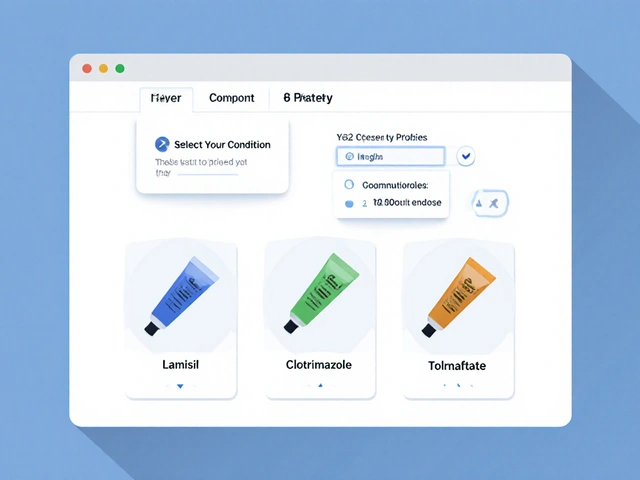Antibiotic Selection Tool
Choose the best antibiotic for your situation
This tool helps you compare Baycip (ciprofloxacin) with alternatives based on infection type, resistance patterns, and patient-specific factors. Results are based on current medical guidelines.
Step 1: Select your infection type
Step 2: Select patient-specific factors
Step 3: Resistance concerns
Key Takeaways
- Baycip is a ciprofloxacin tablet; it’s a fluoroquinolone with broad‑spectrum activity.
- Levofloxacin and moxifloxacin are newer fluoroquinolones that often have better once‑daily dosing.
- Azithromycin, amoxicillin and doxycycline belong to different classes and are useful when resistance to fluoroquinolones is a concern.
- Choose Baycip for uncomplicated urinary‑tract, skin or respiratory infections when the pathogen is known to be susceptible.
- Always check for drug interactions, especially with anti‑arrhythmics or steroids, and finish the full course to avoid resistance.
What is Baycip (Ciprofloxacin)?
Baycip is a brand name for ciprofloxacin tablets used to treat bacterial infections. It belongs to the fluoroquinolone class, which attacks bacterial DNA replication. In the UK it’s typically prescribed as 250mg or 500mg tablets for 3‑7days, depending on the infection site.
How does Ciprofloxacin work?
Ciprofloxacin inhibits two key enzymes - DNA gyrase and topoisomeraseIV - that bacteria need to unwind and reseal their DNA. Without these enzymes, bacterial cells can’t duplicate or repair their genetic material, leading to bacterial death. This mechanism makes it effective against Gram‑negative rods, some Gram‑positive cocci and atypical organisms.
Common alternatives to Baycip
When doctors consider a different drug, they look at spectrum, dosing convenience, side‑effect profile and local resistance patterns. Below are the most frequently mentioned alternatives.
Levofloxacin
Levofloxacin is a newer fluoroquinolone that offers once‑daily dosing for many infections, which can improve adherence. It shares the same core mechanism as ciprofloxacin but often shows better activity against respiratory pathogens like Streptococcus pneumoniae.
Moxifloxacin
Moxifloxacin is a broad‑spectrum fluoroquinolone with strong activity against anaerobes and atypical organisms, making it a go‑to for complicated pneumonia. The price is higher, and it’s usually reserved for cases where other options have failed.
Azithromycin
Azithromycin is a macrolide antibiotic that works by blocking bacterial protein synthesis. It’s often chosen for patients who can’t tolerate fluoroquinolones or when the suspected bug is Mycoplasma or Chlamydia.
Amoxicillin
Amoxicillin is a beta‑lactam penicillin that interferes with cell‑wall synthesis. It’s inexpensive, has a long safety record, and is effective for many ear, nose, throat and urinary‑tract infections caused by susceptible strains.
Doxycycline
Doxycycline is a tetracycline that also blocks protein synthesis, but it is especially useful for tick‑borne illnesses, acne and atypical pneumonia. It requires a 30‑minute fast before each dose to improve absorption.

Side‑effects and safety considerations
All fluoroquinolones, including Baycip, carry warnings about tendinitis, QT‑interval prolongation and potential effects on developing cartilage. Common mild reactions are nausea, Diarrhea and headache. In contrast, azithromycin may cause stomach upset but rarely affects the heart, while amoxicillin’s main risk is allergic reaction.
Resistance trends in 2025
The FDA reports that fluoroquinolone resistance among E. coli urinary isolates has risen to roughly 20% in the UK and Europe. This makes it crucial to confirm susceptibility before prescribing Baycip for recurrent UTIs. Alternatives like nitrofurantoin or fosfomycin are often preferred for uncomplicated cases.
Comparison table
| Drug | Class | Typical Dose (Adults) | Broad‑Spectrum Coverage | Common Side‑Effects | Resistance Concerns (2025) |
|---|---|---|---|---|---|
| Baycip (Ciprofloxacin) | Fluoroquinolone | 500mg PO q12h | Gram‑negatives, some Gram‑positives, atypicals | Nausea, tendonitis, QT prolongation | ~20% E. coli resistance |
| Levofloxacin | Fluoroquinolone | 750mg PO q24h | Similar to ciprofloxacin, better respiratory coverage | Headache, dizziness, tendon issues | ~15% respiratory isolates |
| Moxifloxacin | Fluoroquinolone | 400mg PO q24h | Broad, strong anaerobic & atypical | GI upset, photosensitivity | Low but rising in ICU settings |
| Azithromycin | Macrolide | 500mg PO day1, then 250mg q24h ×4 | Gram‑positives, atypicals, some Gram‑negatives | Diarrhea, mild QT prolongation | Resistance in S. pneumoniae ~30% |
| Amoxicillin | Penicillin (beta‑lactam) | 500mg PO q8h | Gram‑positives, some Gram‑negatives | Allergy, mild GI upset | Beta‑lactamase producers increasing |
| Doxycycline | Tetracycline | 100mg PO q12h | Atypicals, tick‑borne, some Gram‑negatives | Photosensitivity, esophageal irritation | Rare resistance, but careful with MRSA |

When to choose Baycip over the alternatives
- Confirmed susceptibility: If a culture shows the bug is sensitive to ciprofloxacin, Baycip can be a fast, inexpensive option.
- Deep tissue penetration: Ciprofloxacin reaches bone and prostate well, making it a solid pick for osteomyelitis or prostatitis.
- Short‑course convenience: For uncomplicated urinary‑tract infections, a 3‑day regimen is often enough.
- Avoiding macrolide resistance: In areas where macrolide resistance exceeds 40%, azithromycin may fail, so a fluoroquinolone becomes a safer bet.
On the flip side, if the patient has a history of tendon problems, is on a medication that prolongs the QT interval, or is pregnant, you’d lean toward amoxicillin, doxycycline (if not pregnant) or azithromycin.
Practical tips for patients on Baycip
- Take the tablet with a full glass of water and stay upright for at least 30minutes to reduce stomach irritation.
- Do NOT use antacids containing magnesium or aluminum within two hours of the dose - they can lower absorption.
- Complete the full prescription, even if you feel better after a couple of days; stopping early fuels resistance.
- Tell your doctor about any heart rhythm disorders, steroid use, or recent tendon pain.
- Store tablets at room temperature, away from moisture and direct sunlight.
If you’re weighing Baycip against the other drugs listed, ask your pharmacist for a side‑by‑side sheet that outlines dosing frequency and common interactions. That simple comparison can save you a trip back to the GP.
Frequently Asked Questions
Can I use Baycip for a common cold?
No. Baycip treats bacterial infections; a cold is viral, so the drug won’t help and may cause unnecessary side‑effects.
Is it safe to take Baycip while on a blood thinner?
Generally yes, but both drugs can increase bleeding risk. Discuss dosage and monitoring with your doctor.
How does Baycip compare to levofloxacin for pneumonia?
Levofloxacin often has better activity against typical pneumonia bugs like S. pneumoniae. If the pathogen is unknown, many clinicians start with levofloxacin for broader coverage.
What should I do if I develop tendon pain while on Baycip?
Stop the medication immediately and contact a healthcare professional. Tendon issues can become serious if the drug continues.
Can children take Baycip?
Ciprofloxacin is usually avoided in children unless there’s no safer alternative, because of potential effects on developing cartilage.




Dennis Owiti
October 16, 2025 AT 13:41I totally get how overwhelming the antibiotic options can feel, especially when you’re juggling side‑effects and dosing schedules. Baycip is a solid choice for straightforward UTIs, but always double‑check that the bug is actually susceptible before you dive in.
Justin Durden
October 16, 2025 AT 17:51Yeah, that makes sense. Just remember to keep the water glass handy and stay upright for a bit after each dose – it really helps with stomach comfort. If you ever feel unsure, a quick chat with your pharmacist can clear up a lot of the confusion.
Michael Christian
October 16, 2025 AT 22:01Baycip works well when you need quick coverage and the infection is proven to respond. It hits the gram‑negative bugs hard and gets into bone and prostate tissue nicely. Still, keep an eye on tendon pain – that’s a red flag you shouldn’t ignore.
Steven Elliott
October 17, 2025 AT 02:11Oh sure, because everyone loves a drug that can turn your tendons into spaghetti. Why not just pick the newest fluoroquinolone and hope it doesn’t make your heart skip a beat? Classic pharma marketing, right?
Lawrence D. Law
October 17, 2025 AT 06:21Baycip remains an efficacious option for select infections; however, clinicians must assess resistance patterns diligently.
Mary K
October 17, 2025 AT 10:31Imagine the dance of molecules as they slip into bacterial DNA, halting replication with a graceful twirl-Baycip sings that song brilliantly. Yet, the world of antibiotics is a kaleidoscope; levofloxacin waltzes in with once‑daily convenience, while azithromycin hums a macrolide lullaby for atypical bugs. It’s a symphony of choices, each instrument playing its part, and the conductor-your prescriber-must balance efficacy, safety, and the ever‑looming specter of resistance.
Brennan Keeler
October 17, 2025 AT 14:41From a pragmatic standpoint, Baycip's pharmacokinetic profile aligns with the therapeutic window required for deep tissue infections; leveraging its high bioavailability can mitigate the need for pricier alternatives. However, one must not overlook the geopolitical implications of antibiotic stewardship-overprescribing fluoroquinolones fuels resistance on a national scale, jeopardizing our collective health security.
ankush kumar
October 17, 2025 AT 18:51Hey folks, let me break this down in plain English because I know these drug charts can be a bit intimidating. First off, Baycip (that's just ciprofloxacin under a brand name) is like the reliable sedan of antibiotics – it gets you where you need to go without too many fancy extras, but you still have to keep up with maintenance. If you have a simple urinary‑tract infection and the lab says the bacteria are sensitive, Baycip is usually the most cost‑effective pick – you won’t be breaking the bank and you’ll finish the course in a few days.
Now, compare that to levofloxacin – think of it as the hybrid car that only needs a single dose a day. It’s great for people who might forget to take meds twice daily, but it can be a bit pricier and sometimes the bacteria have already started building resistance to it.
Moxifloxacin is even more of a luxury SUV – it covers a wider range of bugs, especially the tough anaerobes, but you only pull it out when other cars (or antibiotics) fail because it’s expensive and you want to save it for complicated pneumonia cases.
Then you have azithromycin, the trusty compact that’s easy on the stomach and works well for atypical infections like Mycoplasma, but it’s not the best for gram‑negative rods that ciprofloxacin loves to chase away.
Amoxicillin is the old‑school hatchback – cheap, well‑known, and perfect for ear, nose, throat infections, but if the bug makes beta‑lactamase, it’s like trying to drive with flat tires.
Doxycycline is the off‑road vehicle for tick‑borne diseases and acne, but remember to take it with a full glass of water and stay upright – the stomach can be a rough ride otherwise.
Side‑effects? All fluoroquinolones, including Baycip, come with a warning label about tendinitis and possible QT‑interval changes, so if you’ve had tendon pain before or have a heart rhythm issue, you might want to steer clear.
Finally, the big picture: antibiotic resistance is rising, especially for ciprofloxacin against E. coli – we’re looking at about a 20 % resistance rate in Europe. That means doctors should only prescribe Baycip when they’re pretty sure it’ll work, otherwise you risk feeding the resistant bacteria pool. So, talk to your pharmacist, ask for a side‑by‑side comparison sheet, and make an informed decision. Stay safe out there!
Christopher Ellis
October 17, 2025 AT 23:01In the grand tapestry of medical choices we find ourselves navigating a labyrinth where each pathway reflects both empirical evidence and the subtle currents of societal expectation the soul of healing is ever in flux.
kathy v
October 18, 2025 AT 03:11Honestly, it's astonishing how many people still think a one‑size‑fits‑all approach works in antimicrobial therapy. The nuance in selecting Baycip over levofloxacin or azithromycin is not just about dosing convenience; it's about respecting the microbial ecosystem and acknowledging that overuse of any fluoroquinolone accelerates resistance on a national scale. If you ignore local antibiograms, you’re basically gambling with public health, and that kind of cavalier attitude should be called out. We need clinicians who are vigilant, not complacent, and patients who understand that taking shortcuts today can mean fewer effective drugs tomorrow. The bottom line: prescribe responsibly, educate thoroughly, and always consider the long‑term implications of each prescription.
Jorge Hernandez
October 18, 2025 AT 07:21Great points everyone 👍 Remember to keep that water glass handy with Baycip and stay upright for a bit after each dose – it really helps with stomach comfort 😊 If you ever feel unsure, a quick chat with your pharmacist can clear up a lot of the confusion